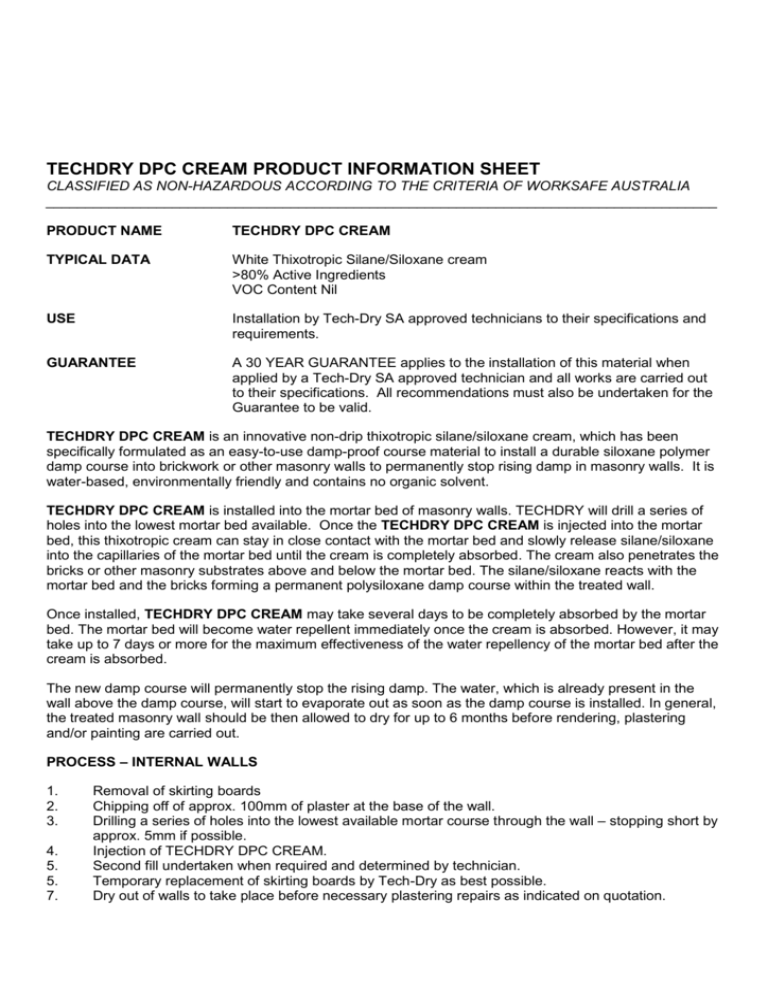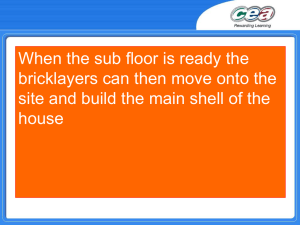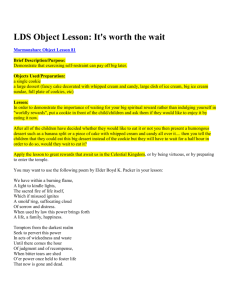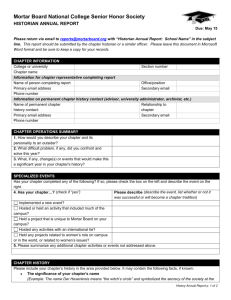techdry dpc cream product information sheet - Tech
advertisement

TECHDRY DPC CREAM PRODUCT INFORMATION SHEET CLASSIFIED AS NON-HAZARDOUS ACCORDING TO THE CRITERIA OF WORKSAFE AUSTRALIA _____________________________________________________________________________________ PRODUCT NAME TECHDRY DPC CREAM TYPICAL DATA White Thixotropic Silane/Siloxane cream >80% Active Ingredients VOC Content Nil USE Installation by Tech-Dry SA approved technicians to their specifications and requirements. GUARANTEE A 30 YEAR GUARANTEE applies to the installation of this material when applied by a Tech-Dry SA approved technician and all works are carried out to their specifications. All recommendations must also be undertaken for the Guarantee to be valid. TECHDRY DPC CREAM is an innovative non-drip thixotropic silane/siloxane cream, which has been specifically formulated as an easy-to-use damp-proof course material to install a durable siloxane polymer damp course into brickwork or other masonry walls to permanently stop rising damp in masonry walls. It is water-based, environmentally friendly and contains no organic solvent. TECHDRY DPC CREAM is installed into the mortar bed of masonry walls. TECHDRY will drill a series of holes into the lowest mortar bed available. Once the TECHDRY DPC CREAM is injected into the mortar bed, this thixotropic cream can stay in close contact with the mortar bed and slowly release silane/siloxane into the capillaries of the mortar bed until the cream is completely absorbed. The cream also penetrates the bricks or other masonry substrates above and below the mortar bed. The silane/siloxane reacts with the mortar bed and the bricks forming a permanent polysiloxane damp course within the treated wall. Once installed, TECHDRY DPC CREAM may take several days to be completely absorbed by the mortar bed. The mortar bed will become water repellent immediately once the cream is absorbed. However, it may take up to 7 days or more for the maximum effectiveness of the water repellency of the mortar bed after the cream is absorbed. The new damp course will permanently stop the rising damp. The water, which is already present in the wall above the damp course, will start to evaporate out as soon as the damp course is installed. In general, the treated masonry wall should be then allowed to dry for up to 6 months before rendering, plastering and/or painting are carried out. PROCESS – INTERNAL WALLS 1. 2. 3. 4. 5. 5. 7. Removal of skirting boards Chipping off of approx. 100mm of plaster at the base of the wall. Drilling a series of holes into the lowest available mortar course through the wall – stopping short by approx. 5mm if possible. Injection of TECHDRY DPC CREAM. Second fill undertaken when required and determined by technician. Temporary replacement of skirting boards by Tech-Dry as best possible. Dry out of walls to take place before necessary plastering repairs as indicated on quotation. PROCESS – EXTERNAL WALLS 1. 2. 3. 4. 5. Drilling a series of holes into the lowest available area as indicated on the wall. Where possible the holes will be drilled into mortar course, or into the stones at the base of the wall as best determined by the technician when on site. Injection or diffusion of TECHDRY DPC CREAM into the holes. Second fill undertaken when required and determined by technician. Filling of face wall holes (if specified / not to match) unless stonemasonry repointing has been quoted or recommended. Dry out of walls to take place before necessary repointing, stonemasonry repairs as indicated on quotation. PROCESS - RE-PLASTERING Any salt damp problem will likely mean that there has been salt contamination of the existing plasterwork and underlying masonry. These salts on their own can cause spoiling to your wall decorations (paint, wallpaper, tiles etc.) even in relatively low quantities. The importance of removing these salts is as high as the importance of the salt damp treatment. Often towards the end or after the specified dry out period you will actually notice that the plasterwork is drummier, and can even look wet. This is due to the salts on the plaster surface drawing moisture from the air and causing the wall to look and feel wet. 1. Skirting’s are removed. 2. Affected plaster is chipped off to heights as specified. 3. Solid TECHDRY Salt Retardant plaster is applied to walls. PLEASE NOTE: A small gap is left between the finish of the plasterwork and the floor. This gap is to ensure the new damp proof course is not bridged but will be covered when the skirting boards/ skirting tiles are replaced. After a 4-week curing period the client is then able to refit skirting’s, sand, finish and flush join between the new and old plaster, repaint and redecorate. (All to be organised by client). For more information TECHDRY SA 244-246 Payneham Road PAYNEHAM SA 5070 Phone: 08 8132 1166 Email: info@stopsaltdamp.com.au Web: www.stopsaltdamp.com.au





